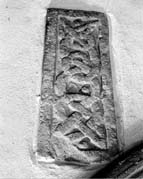Select a site alphabetically from the choices shown in the box below. Alternatively, browse sculptural examples using the Forward/Back buttons.
Chapters for this volume, along with copies of original in-text images, are available here.
Object type: Probably top of a cross-shaft
Measurements: H. 51 cm (20 in); W. 23.5 > 18 cm (9.25 > 7 in); D. Built in
Stone type: Pale yellow-brown (10YR 8/4) oolitic limestone, with ooliths of about 0.5mm diameter, pellets up to 2 to 3mm and numerous shell fragments about 5mm in diameter. The lithological resemblance of this stone to that at Inglesham (p. 217) suggests it to be Taynton stone, from the Taynton Limestone Formation, Great Oolite Group, Middle Jurassic of Taynton, Oxfordshire.
Plate numbers in printed volume: Pl. 446
Corpus volume reference: Vol 7 p. 214
(There may be more views or larger images available for this item. Click on the thumbnail image to view.)
Only one face is visible and this seems most likely to be one of the sides. This face, which is a complete panel, is edged by a flat-band moulding. It encloses a irregular non-geometric interlace. At the top are two pointed loops and a loose twist, and two strands then cross and loop to form a single spiral knot, and terminate in two pointed loops at the base. There are three loose pellets in the spaces between the strands.
Although the pattern is muddled the strands are carved with a true under and over technique, with some local competence. This piece is unusual in the south-west in that the strands are not median-incised. Romilly Allen found that 'the knotwork presents some remarkable peculiarities' (Allen 1894, 52). The lack of geometric regularity is not unusual in Wessex, and is not necessarily due to incompetence (see introduction p. 41); however, this piece may look more to Midland than Wessex traditions, and this is supported also by the stone type which has been used.



